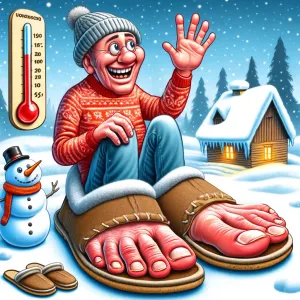Comprehensive Guide to Understanding Chilblains: Causes, Symptoms, and Treatments

Introduction to Chilblains #
Chilblains are painful, inflamed patches of skin that arise from exposure to cold, damp environments. These irritations typically develop on the toes and fingers and, while they generally heal on their own within a few weeks, maintaining warmth and dryness is crucial for quicker recovery.
Steply insoles and slippers, which feature arch support, are effective in alleviating and preventing foot pain associated with cold weather, including chilblains. This article will delve into the causes, symptoms, and treatments for chilblains.
What Causes Painful Toes in Cold Weather? #
Commonly known as pernio or perniosis, chilblains can affect the feet, hands, ears, face, and lower legs. Poor circulation is a key factor; in cold conditions, the small blood vessels near the skin constrict and may expand too rapidly when warmed, causing fluid leakage into surrounding tissues. This results in swelling and discomfort. Wearing wool arch support inserts can improve blood flow and keep feet warm.
Identifying Chilblains #
Chilblains manifest as red, swollen patches that can appear within hours of exposure to the cold and wet. The affected areas may blister and look shiny due to swelling. In individuals with darker skin tones, chilblains may appear purple or blue.
Symptoms of Chilblains #
The symptoms typically emerge after exposure to cold, when the affected area begins to warm:
- Redness and swelling
- Blisters or sores
- Itching
- Burning or stinging sensations
- Tenderness
Chilblains occur in cold but not freezing temperatures, differentiating them from frostbite. If you are experiencing similar symptoms and are unsure of the temperature exposure, consult a healthcare provider.
Explaining the Pain from Chilblains #
In cold conditions, the body prioritizes warming the core, reducing blood flow to extremities and leading to inflammation. Upon rewarming, the sudden blood flow increase can cause swelling and nerve irritation, resulting in pain.
Causes and Risk Factors #
While the precise cause of chilblains is unclear, they are believed to be linked to poor circulation. Risk factors include:
- Wearing tight clothing or footwear
- Being a woman aged between 15 and 30
- Low body mass or underweight
- Living in cold, humid climates
- Family history of chilblains
- Hormonal changes
Certain medical conditions like Raynaud’s syndrome, lupus, and diabetes also increase the risk of chilblains, making foot care extremely important for those affected.
Treating Chilblains with Self-Care #
Comfortable feet are healthy feet, and orthotic insoles play a key role in keeping your feet pain-free by providing support, stability, and temperature regulation. For example, Steply’s orthotic slippers feature removable wool insoles that offer warmth and protection.
Effective self-care measures include:
- Limiting cold exposure
- Gradually warming up with blankets or warm clothing
- Avoiding direct heat application
- Not rubbing or massaging the affected areas
- Moisturizing with unscented lotions or anti-inflammatory creams
- Wearing loose, warm layers including hats, gloves, and moisture-wicking socks
- Avoiding barefoot walking on cold surfaces
- Wearing water-resistant shoes with wool insole support
Staying active during winter can improve circulation and overall health. Indoor activities like treadmill walking or cycling are good alternatives when it's too cold outside. Smokers are advised to quit as smoking can impair circulation and delay healing.
When to Consult a Doctor #
If chilblains symptoms persist beyond two weeks, it's advisable to see a healthcare provider. Diagnosis may involve a physical examination and possibly blood tests to identify any underlying issues. Treatments may include topical corticosteroids or blood pressure medications.
Immediate medical attention is necessary if there’s uncertainty about exposure to freezing temperatures, as this could indicate frostbite rather than chilblains.
Preventing Cold Weather Foot Pain #
While Steply insoles do not treat chilblains directly, they help maintain proper foot alignment and encourage blood flow, aiding in the prevention of painful foot conditions during cold weather.